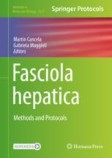Search
Search Results
-
Optimization of Small-Scale Production of Zika Virus Envelope Glycoprotein by Transient Expression in HEK293 Cells for ELISA
Zika virus (ZIKV) is an emerging mosquito-borne flavivirus, which has recently caused global epidemics with its association with congenital Zika...
-
Liver Fluke Vaccine Assessment in Cattle
Liver fluke Fasciola hepatica remains an important agent of foodborne trematode disease producing great economic losses due to its negative effect on...
-
Analysis of Gene Expression in Fasciola hepatica Juveniles and Adults by In Situ Hybridization
In situ hybridization (ISH) is a technique used for the spatial localization of nucleic acids within tissues and cells. It is based on the ability of...
-
Gene Silencing in the Liver Fluke Fasciola hepatica: RNA Interference
The chronic infection with the liver fluke of the genus Fasciola spp. is the most prevalent foodborne trematodiasis, affecting at least one-fourth of...
-
Evasion of Host Immunity During Fasciola hepatica Infection
Fasciola hepatica, the common liver fluke, causes infection of livestock throughout temperate regions of the globe. This helminth parasite has an...
-
Correction to: Fasciola hepatica: Methods and Protocols
Unfortunately, chapters 11 and 12 were published without including the name of Prof. Ana Espino. The author’s name has been added now so that the...
-
Droplet Digital PCR and Immunohistochemistry Techniques to Detect Zika Virus in the Central Nervous System of Mice
Detection of Zika virus (ZIKV) in the central nervous system (CNS) is a critical step when studying the pathogenesis of the infection in animal...
-
Maintenance of Life Cycle Stages of Fasciola hepatica in the Laboratory
Fasciola hepatica has a heteroxenous complex life cycle that alternates between an invertebrate intermediate and a mammalian definitive host. The...
-
Microscopical Techniques to Analyze the Hepatic and Peritoneal Changes Caused by Fasciola hepatica Infection
The helminth parasite Fasciola hepatica modulates the host immune response at early stages of infection (Rodríguez et al., PLoS Negl Trop Dis...
-
Isolation and Analysis of Fasciola hepatica Extracellular Vesicles
The finding of extracellular vesicles (EVs) as important players in parasite–parasite and host–parasite communications has led to an increasing...
-
Zika Virus Isolation, Purification, and Titration
Zika virus (ZIKV) is an important pathogen transmitted to humans by the mosquito vector Aedes aegypti. ZIKV is able to infect several tissues and...
-
Use of Primary Human Fetal Astrocytes and Tissue Explants as Ex Vivo Models to Study Zika Virus Infection of the Develo** Brain
Zika virus (ZIKV) infection during pregnancy can result in congenital Zika syndrome which is characterized by microcephaly and other...
-
Use of miRNAs to Study Host Cell–Parasite Interactions
MicroRNAs (miRNAs) represent a subclass of endogenous small noncoding RNAs that have been identified in both mammalian and nonmammalian cells. miRNAs...
-
In Vitro Culture of Cryptosporidium parvum Using Hollow Fiber Bioreactor: Applications for Simultaneous Pharmacokinetic and Pharmacodynamic Evaluation of Test Compounds
Hollow fiber technology is a powerful tool for the culture of difficult-to-grow cells. Cryptosporidium parvum has a multistage sexual and asexual...
-
High-Content Screening for Cryptosporidium Drug Discovery
High-content screening (HCS) is a cell-based type of phenotypic screening that combines multiple simultaneous readouts with a high level of...
-
Calf Clinical Model of Cryptosporidiosis for Efficacy Evaluation of Therapeutics
Cryptosporidiosis, caused by the apicomplexan parasite Cryptosporidium parvum, is a moderate-to-severe diarrheal disease now recognized as one of the...
-
Detection of Cryptosporidium Recovered from Large-Volume Water Samples Using Dead-End Ultrafiltration
The procedure described here provides instructions for detection of Cryptosporidium recovered from large-volume water samples. Water samples are...
-
Two- and Three-Dimensional Bioengineered Human Intestinal Tissue Models for Cryptosporidium
Conventional cell cultures utilizing transformed or immortalized cell lines or primary human epithelial cells have played a fundamental role in...
-
Cell Culture Infectivity to Assess Chlorine Disinfection of Cryptosporidium Oocysts in Water
This chapter provides a detailed protocol to assess disinfection efficacy of chlorine against Cryptosporidium oocysts including the core chlorine...
-
Mouse Models for Use in Cryptosporidium Infection Studies and Quantification of Parasite Burden Using Flow Cytometry, qPCR, and Histopathology
Cryptosporidiosis threatens life of young children in develo** countries and newborn calves around the world. No vaccine or therapy can prevent or...
